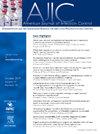COVID-19之前和期间中国一家三甲医院医院获得性感染和社区获得性感染的对比分析:为期7年的纵向研究(2017-2023年)。
IF 2.4
3区 医学
Q2 INFECTIOUS DISEASES
引用次数: 0
摘要
背景:COVID-19大流行深刻影响了全球医疗系统中医院获得性感染(HAIs)和社区获得性感染(CAIs)的动态变化。这项为期 7 年的纵向调查(2017-2023 年)评估了中国一家一级三甲医院在大流行之前和期间的 HAI 和 CAI 点流行率:将患者分为大流行前和大流行期间,以及严格和宽松的感染预防与控制(IPC)阶段,以比较HAIs和CAIs的点流行率。采用多变量逻辑回归来确定与 HAIs 相关的风险因素:2017年至2023年期间,共对15296名住院患者进行了评估。HAIs的总体点流行率为1.50%(95%置信区间[CI],1.32%-1.71%),呈显著下降趋势(P = 0.021)。相反,CAI 的总发病率为 24.49%(95% 置信区间 [CI],23.81%-25.18%),呈明显上升趋势(P < 0.001)。在接受病原体检测的患者中,HAIs 的点流行率在大流行期间显著下降(6.26% vs. 9.89%,P < 0.001),尤其是呼吸道 HAIs(3.83% vs. 6.89%,P < 0.001)。与 2020-2022 年相比,2023 年病原体检测患者的 CAI 点流行率明显上升(81.37% 对 74.18%,P = 0.001)。多变量分析表明,大流行期间的住院治疗是预防 HAIs 的保护因素(调整后的几率比 0.49,95% CI,0.36-0.67):结论:这所三级医院在 COVID-19 大流行期间实施了全面的 IPC 战略,大大降低了 HAIs 的点流行率。然而,COVID-19 IPC措施放松后,CAI呈上升趋势。本文章由计算机程序翻译,如有差异,请以英文原文为准。
Comparative analysis of hospital-acquired and community-acquired infections at a tertiary hospital in China before and during COVID-19: A 7-year longitudinal study (2017-2023)
Background
This 7-year longitudinal survey (2017-2023) assessed the point prevalence of hospital-acquired infections (HAIs) and community-acquired infections (CAIs) at a first-class tertiary hospital in China, both prior to and during the Corona Virus Disease 2019 (COVID-19) pandemic.
Methods
Patients were stratified into prepandemic and pandemic periods, as well as into stringent and relaxed infection prevention and control (IPC) phases, to compare the point prevalence of HAIs and CAIs.
Results
The overall point prevalence of HAIs was 1.50% (95% confidence interval [CI], 1.32%-1.71%), showing a significant downward trend (P = .021). Among patients receiving pathogen testing, the point prevalence of HAIs significantly declined during the pandemic (6.26% vs 9.89%, P < .001). The point prevalence of CAIs demonstrated a notable increase in 2023 compared with 2020 to 2022 among pathogen-tested patients (81.37% vs 74.18%, P = .001). Multivariate analysis identified hospitalization during the pandemic as a protective factor against HAIs (adjusted odds ratio 0.49, 95% CI, 0.36-0.67).
Conclusions
The comprehensive IPC strategy implemented during the COVID-19 pandemic at this tertiary hospital significantly reduced the point prevalence of HAIs. However, CAIs exhibited a rising trend following the relaxation of COVID-19 IPC measures.
求助全文
通过发布文献求助,成功后即可免费获取论文全文。
去求助
来源期刊
CiteScore
7.40
自引率
4.10%
发文量
479
审稿时长
24 days
期刊介绍:
AJIC covers key topics and issues in infection control and epidemiology. Infection control professionals, including physicians, nurses, and epidemiologists, rely on AJIC for peer-reviewed articles covering clinical topics as well as original research. As the official publication of the Association for Professionals in Infection Control and Epidemiology (APIC)

 求助内容:
求助内容: 应助结果提醒方式:
应助结果提醒方式:


